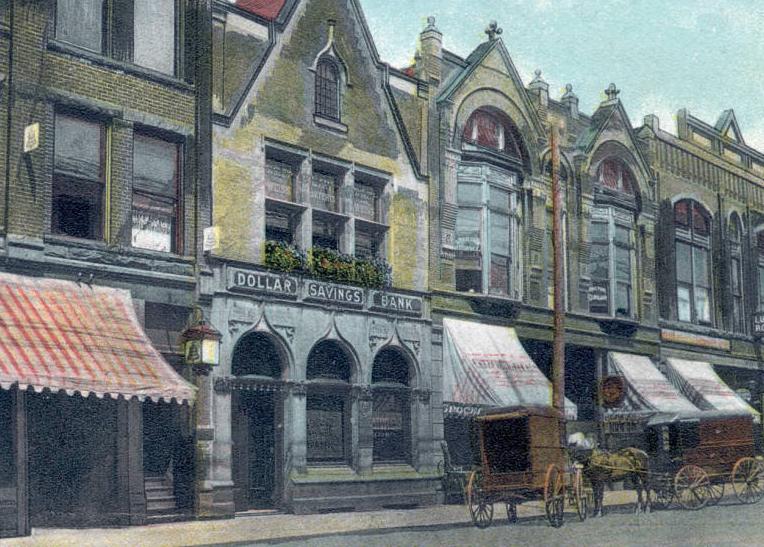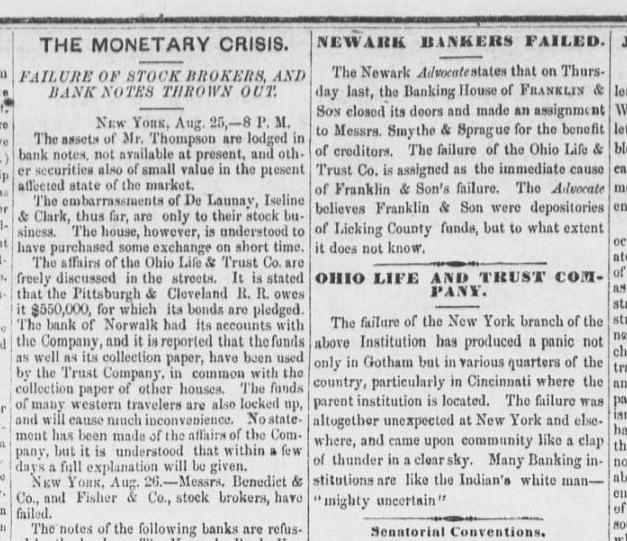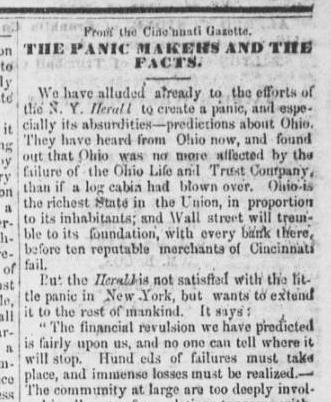Fortunes Made and Lost: The Panic of 1857

August 24th is an important day in the economic history of Ohio and of the nation–on this date in 1857, the New York branch of the Ohio Life Insurance and Trust Company failed, due in part to bad agricultural investments, and in part to reported embezzlement of funds at its home office in Cincinnati. The resulting restrictions by New York bankers on all customer transactions triggered a panic as depositors suspected a financial collapse was underway. Bank patrons started withdrawing massive amounts from their accounts, while at the same time rushing to sell off stocks and paper bonds. News of the panic spread quickly through East Coast states and beyond thanks to the recent invention of the telegraph, creating a domino effect that led to bank and business closures around the country. This in turn left many without work, and therefore without money to patronize those businesses still in operation.
Several other underlying causes contributed to the Panic of 1857. Chief among these was a decline in European imports of American agricultural products following the Crimean War, as soldiers returned to their former lives on the farm and reduced the need for American crops. Defaulting by railroad companies on planned rail routes, and the failed projects that resulted, also contributed to the panic, as did the mid-September sinking of the SS Central America, a steamboat carrying over 30,000 pounds of gold specie from San Francisco and destined for U.S. banks on the East Coast.


Historic newspapers on Ohio Memory allow you to read about the Panic and subsequent recession from various perspectives as it was happening. The Mt. Vernon Republican published several pieces on the Panic one week after the events of August 24th, seen above, reporting on its repercussions “not only in Gotham but in various quarters of the country.” But soon, the Republican was running stories advising against drastic measures and implying that other papers were exaggerating the crisis, as in the article at right titled “The Panic Makers and the Facts.” In it, they state that Ohio has been “no more affected by the failure of the Ohio Life and Trust Company than if a log cabin had blown over.”
Both the Republican and the Ohio State Journal gave calming advice to readers, reminding them respectively of similar events just 20 years earlier, and to avoid panic, which “strikes with the greatest force upon those who are least informed, and least capable of… looking through the clouds of the present into the light of the future.”
While an Ohio bank’s failure triggered the Panic of 1857, Ohioans as a whole were able to weather the depression relatively well. Some businesses failed, but most banking institutions survived. The Republican Party, then in control of the Ohio legislature and governor’s seat, lost some power to the Democratic Party, who gained control of the Ohio General Assembly. The United States’ economy rebounded during 1859, saving the nation from as serious a depression as occurred during the Panic of 1837, although the effects of the 1857 Panic continued to be felt until the outbreak of the Civil War.
Thanks to Lily Birkhimer, Digital Projects Coordinator at the Ohio History Connection, for this week’s post!



Leave a Reply
You must be logged in to post a comment.